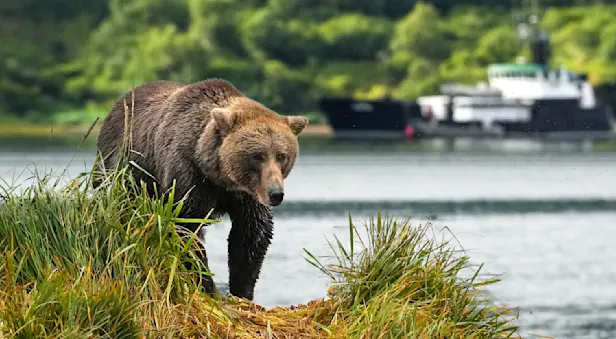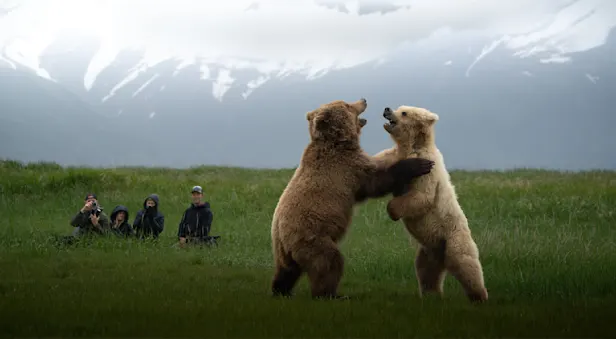
Know Before You Go
When to Go—The Ebbs and Flows of Grizzly Bear Season in Alaska's Katmai Region
The following description of the typical patterns of brown bear migration and seasonal weather in Alaska's Katmai region is gleaned from our more than a decade's experience operating the world’s greatest grizzly adventures. Every day, inquiring clients ask our Adventure Specialists, “When is the best time to go?” While that is an impossible question to answer with 100-percent accuracy (after all, we cannot control nature), the best time to go truly depends on the specifics of the experience you are seeking. The details below will help you answer that question according to your own wishes and interests.
An important note: Please keep in mind that over the many years we have shared this amazing place with nature lovers, we've found that it tends to be that single incredible experience with one bear that makes an entire trip meaningful, not a simple tally of seeing “X” number of bears.
June
June is when bears on the Katmai coast converge to socialize, mate and utilize food sources supplied by the ocean. Long-awaited extended hours of sunlight and warmth supercharge the rich marine habitat, resulting in an explosion of growth at every trophic level of the ecosystem, from algae all the way to brown bears. During high tides, seawater floods into the glacial river valleys creating extensive intertidal meadows where bears congregate to feed on protein-rich sedges and plants. During low tides, the bears wander into the tidal flats to search for razor clams. Containing several of the most active brown bear mating grounds in the world, the Katmai coast’s mating season peaks in mid-to-late June. Play behavior among sows, cubs, and sub-adults is at its highest in the early summer. Since the bears are not engrossed in fishing until later in the summer, during a single afternoon excursion it would not be unusual to witness sparring adolescent males, a female nursing her cubs, two giant males engaged in a brutal fight over a female, and the intimate interactions of a mating pair.
July
July is a month of transition, which offers a diverse "mixed bag" of bear behaviors. As in June, bears are still found grazing in the coastal sedge meadows and pursuing razor, butter and steamer clams at low tides. Some sows come into estrus in early and mid-July, providing potential opportunities to witness the complex and fascinating mating season interactions. While the timing of early salmon runs is unpredictable from one year to the next, schools usually begin congregating at the mouths of some rivers during high-tide cycles in the latter half of July, adding excitement to an already fantastic period. As mating season winds down, many of the nomadic large males disperse into the surrounding wilderness while females with small 6-month old cubs appear magically in the rich habitat zones we frequent. Typical July excursions often consist of spending intimate moments watching bear families play, nurse and graze. Wildflowers peak throughout the month of July, which draw bears to graze on the sweet stalks and flowers. Bears wading shoulder-deep through a sea of brilliant green meadow grass, highlighted with the reds, whites, yellows, blues and purples of the blooms, is often the highlight on a July bear-viewing trip.
August
In late summer, bears on the coast seem to have one objective—to gorge on plentiful pink salmon running upstream from the sea to spawn. At Geographic Harbor and near Kinak Bay, bears of all sizes and ages, preparing for the harsh Alaskan winter, converge at shallow tidal estuaries to feast on nutritious salmon, rich in protein and fat. August is still a time of plenty for the eager bears, and they make the most of their opportunities to augment their protective fat reserves at every chance. Huge, solitary males and females with one to three spring or yearling cubs prowl the banks and plunge into cold streams, poised to pounce on unsuspecting fish. In the process, adult bears are mostly oblivious to the presence of humans due to their intense concentration on fishing.
September
Autumn comes on fast and in dramatic fashion in the North. September is often an optimal time for photographers who want to capture images of fishing bears exhibiting the most impressive physical appearance, amid beautiful seasonal light conditions. Though the bears continue to graze on select vegetation, browse for berries and sometimes dig clams, they are fishing the vast majority of the time in September. At this point, they have been fishing since late July and thus have gained considerable weight. Most bears appear healthy, act very mellow, and have grown their heavy, bushy coats in anticipation of winter. When a bear proudly carries its hard-won catch to the shore, phenomenal photo opportunities result. Vegetation on the Katmai coast also appears markedly different from earlier in the summer. Wildflowers blossoms have closed and turned to seed or brightly colored berries, while the foliage turns rusty red, brown or yellow. By mid-September, many of the cottonwoods, birches and willows that line the riverbanks have turned bright gold. While the weather can be a little more challenging, with rain more frequent in the fall, there are still crystal-clear days ideal for photography, with low-angle light and splashes of fall color providing the backdrop as we sit on the banks of a river filled with beautiful, satisfied bears.
In Conclusion: The best time to see Alaska's coastal grizzlies and the natural habitat that supports them depends on your own desires for the experience. While time with Katmai's bears is thrilling no matter what the conditions, it is important to approach this adventure having made a carefully informed decision about timing, keeping in mind that nature is unpredictable. As a staff of dedicated nature enthusiasts, naturalists and scientists, we believe that this information best describes what you can expect during our Alaska grizzly bear season. If you have further questions, please talk with one of our Adventure Specialists at 1-800-543-8917.Header Credit: Brad Josephs
Travel to See Grizzlies in Alaska

Alaska's Grizzly Ship: Kodiak to Katmai
An exclusive small-ship adventure to view giant brown bears—the world's largest "coastal grizzlies"—up close! Walk the shores as bears dig for clams, forage for sedges and pursue salmon in season in tidal streams.


Grizzly Ship Photo Expedition: Kodiak to Katmai
Based aboard our private small ship, just eight guests photograph brown bears in the roadless Katmai wilderness, going ashore with an expert bear naturalist and photography pro who knows these animals intimately.






























